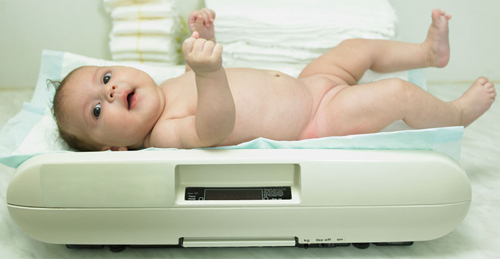It’s natural for new parents to be concerned that their baby is growing and developing at the right speed, and that he is getting the right amount of milk for his needs. Rest assured that within the first few weeks, your new baby will let you know exactly what he needs, and you’ll soon become alert to any potential problems.
| Q: |
How can I tell that my baby is growing normally?
| | A: |
When your baby is born, you’ll be given a growth chart, usually
in the back of your baby’s record book, on which the healthcare
professional will plot her height and weight. The current growth charts
are based mainly on bottle-fed infants, but you can ask for a chart
designed for breastfed babies if your baby is exclusively breastfed. For
the sake of accuracy, it is important to have your baby weighed at her
clinic from time to time, to ensure that you have the correct data.
From birth, your
baby’s height and weight can be plotted on the chart, which is broken up
into percentiles. The percentile charts work on averages so being on
the “50th percentile” for weight or height means your baby is absolutely
average for her age. Similarly, being on the “91st percentile” for
height indicates that your baby is tall for her age. The idea of
plotting these figures is to ensure that your little one remains on much
the same line as she grows. So if she was born heavy, she is likely to
remain heavy throughout infancy and into childhood, and if she was born
smaller than most other babies, she is likely to remain on that line as
well. There will always be upward and downward blips, and it’s important
not to worry too much about these, as they represent normal growth
patterns. What you are looking for is a fairly regular picture over
time. In the short-term, if your baby is alert, putting on weight,
sleeping well, and looks well and content, she will be growing properly
and there is no need for concern.
|
| Q: |
My baby was small at birth and is still slight for his height; should I be worried?
| | A: |
If your baby is on roughly the same percentile line that he was
when he was born, there is absolutely no need for concern. Some children
(and adults) are smaller and slighter than others, and are perfectly
healthy. He may have a significant growth spurt later in childhood,
which may bring him to a more average height and weight, or he may
remain small. If he is healthy and well, and he’s growing normally,
there is nothing to worry about.
|
| Q: |
My baby seems hungry even though I’m giving her the recommended number of feeds. Is it OK to offer more?
| | A: |
All babies have different needs, and formula manufacturers base
their instructions upon the average baby. The best advice is to offer
about 4–5fl oz (120–150ml) of milk per 2lb 3oz of body weight during
each 24-hour period while your baby is below 11lb (5kg). If your baby
still seems hungry, try offering an extra 1–2fl oz (30–60ml) during each
feed, to see if that makes a difference. If your baby’s weight is above
11lb (5kg), she will need 31/3–4 fl oz (100–120ml) per 2lb 3oz of body
weight.
It is important to
follow your baby’s hunger and satiety patterns. If babies demand more,
they often need more. Your baby may be experiencing a growth spurt or she may be trying to tell you that she is ready for solids .
Sometimes very hungry
babies will need a formula with more casein than whey. These take longer
to digest, helping babies to feel fuller for longer.
|

| Q: |
Is it possible to overfeed my baby?
| | A: |
It is possible to overfeed a bottlefed baby, and this can lead to
vomiting, diarrhea, and excess weight gain. It is therefore important
to interpret your baby’s cues and not just feed whenever he feels
unsettled. It is difficult to feed a breastfed baby too much, as you
will make just the right amount of milk that he needs.
Newborns often have
six to eight feeds per day, dropping to four or five by around seven
months. The amount you offer should be based on your baby’s weight (see My baby seems hungry even though I’m giving her the recommended number of feeds. Is it OK to offer more?),
and he should be satisfied by the time he finishes his bottle. There
should always be a little milk left in the bottle at the end of each
feed, so you can be sure he has stopped feeding because he has had
enough milk, rather than because there was no more available. If you
find your baby is always hungry, and putting on weight too quickly, talk
to your doctor about it. It may be that he’s ready to begin weaning .
|
Did you know…
that it’s very important
to weigh your baby on the same scale, with the same clothing (or no
clothing), each time, in order to be sure that you get an accurate
result? Scales can vary enormously, and you don’t want to be sent into a
panic that your baby has suddenly “gained” or “lost” a large amount of
weight. You can expect your baby to put on between 100g (31/2oz) and
225g (8oz) a week in his first few months.

|